What are Check Valves? Types of Check Valves & Their Symbols
What are Check Valves? Types of Check Valves & Their Symbols
Check valves are essential components in fluid control systems. They play a crucial role in preventing the reverse flow of fluids within pipelines or piping systems. Check valves are popular as non-return valves or one-way valves. This comprehensive guide aims to provide a deep understanding of check valves, covering their types, working principles, applications, design considerations, maintenance, and common questions related to these vital components.
What is a Check Valve?
A Check valve is a mechanical device used in piping and pipeline systems to prevent back-flow. Check valves allow fluid flow only in the forward direction that’s why it is called a one-way valve or non-return valve. They work on the principle of differential pressure. It means the check valve will only open if the upstream pressure is more than the downstream pressure. In situations, where downstream pressure is more, the valve will close preventing reverse flow. Closure can also be accomplished by the weight of the check mechanism, by a spring, or by a combination of all these means. Check valves are commonly used in a wide range of industries and applications to ensure the safety, efficiency, and integrity of fluid systems. One of the main applications of check valves is at the pump outlet piping to protect the equipment from flow reversal.
Check valves are automatic valves and unlike other valves, human intervention or external control is not required for their opening or closing. The only purpose of the check valve is to prevent flow reversal or back-flow and they are available in various sizes, designs, and materials.

Working Principle of Check Valves
As already stated, a check valve operates on the principle of differential pressure. For a check valve to open, it must attain a minimum upstream pressure known as cracking pressure. Depending on the check valve design and size, the cracking pressure changes. When the upstream pressure reaches the cracking pressure, the valve opens allowing the fluid to enter. When the upstream pressure falls below the cracking pressure, back pressure is generated, and the flow attempts to move from the outlet to the inlet. At this point, the check valve closes, and the flow halts. The closing mechanism of a check valve varies depending on the design and type of the valve. Spring or Gravity pressure normally assists the closing process.
As the check valve works only in one direction, manufacturers provide an arrow on the valve body indicating the flow direction.

Types of Check Valves
Depending on the movement of the closure member, various types of check valves are available.
- Swing Check Valve
- Wafer Check Valve
- Spring Loaded Check Valves
- Spring Loaded Inline Valves
- Spring Loaded Y
- Ball Check Valves
- Diaphragm check valves
- Lift check valve
- Stop check valve
- Foot Valve
- Duckbill Valve
- Dual Plate Check Valve

Swing Check Valve
A swing check valve is the most common and widely used check valve. The closing member or the disc swings on a hinge or shaft. To allow the flow, the disc swings off the seat and swings back onto the seat to block the reverse flow. In an open position, a swing check valve offers very little resistance to the flow. To achieve optimum performance, often a lever and weight or a lever and spring are mounted. The disc weight and the return flow have an impact on the shut-off characteristics of the valve.
An improved version of swing check valves is known as Tilting Disc Check Valves. It uses a disc that tilts on a hinge to allow or block flow. This design offers improved sealing performance compared to swing check valves and is often used in high-pressure or high-velocity applications.
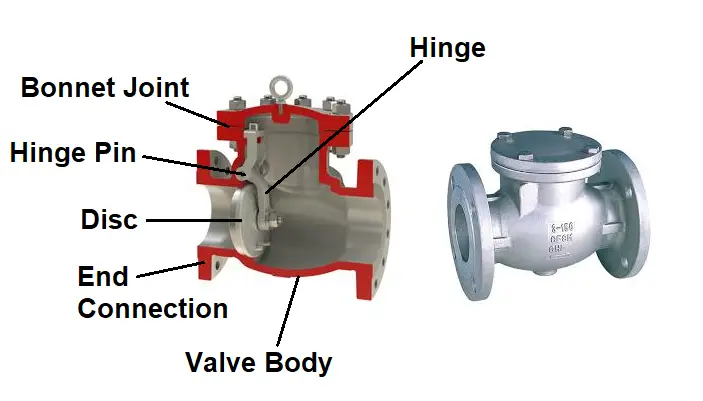
The swing check valve allows full, unobstructed flow and automatically closes once pressure decreases. The following animation video explains the main parts and working methodology of a typical Swing Check Valve
Wafer Check Valve
Wafer check valves are very slim and compact in design and use a swinging disc to allow or block flow. They are lightweight and suitable for various applications. They are economical and are available in various sizes. The following figure shows the typical working of a Wafer Check Valve.
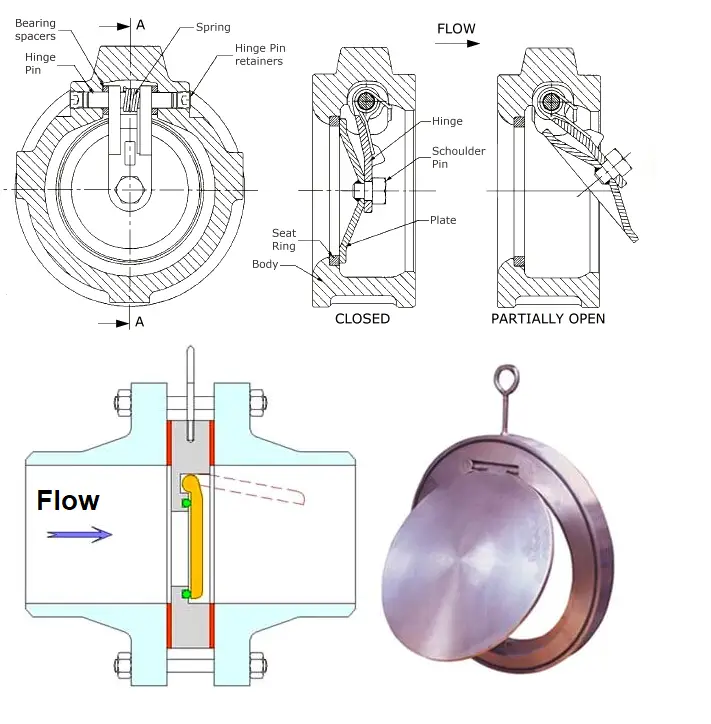
Wafer check valves are ideal for services requiring low-pressure loss as the valve operation takes place at a very low-pressure difference.
Spring Loaded Check Valves
There are two types of Spring spring-loaded check Valves; Spring-Loaded in-line valves and spring-loaded Y-valves.

In-line valves are also known as Nozzle Check Valves or Silent Check Valves. These valves employ a centrally guided stem-disc assembly along with a compression spring. To open the valve, the flow pressure must be more than the spring force and cracking pressure. In that case, the flow pushes the disc allowing the flow. When the inlet pressure reduces, the spring pushes the disc against the orifice and shuts the valve.
The operating principle of Spring-loaded y-check valves is similar to in-line check valves. The only difference is that the spring and movable disc are located at an angle to form a ‘y’ shape. The main advantage of Y-type check valves is that they can be inspected and serviced while the valve is still connected to the system.
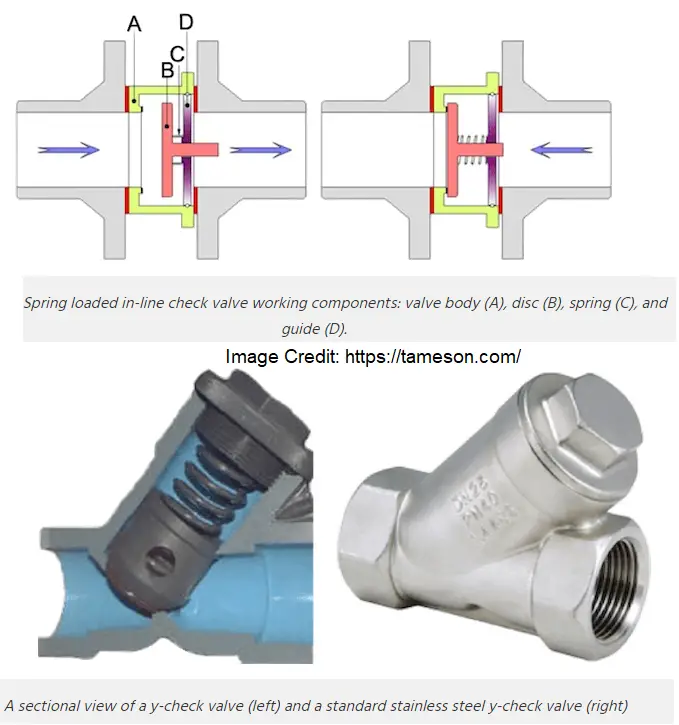
Ball Check Valves
Ball check valves are simple in operation and commonly used on small pumps and in low-head systems. Ball check valves involve a spring-loaded or free-floating spherical ball clapper to shut at pressures below the cracking pressure. In order to guide the ball into the seat and create a positive seal, the sealing seat is conically tapered. However, these valves can easily wear due to prolonged use and require frequent maintenance. Ball check valves are widely used for their simplicity and low pressure drop.

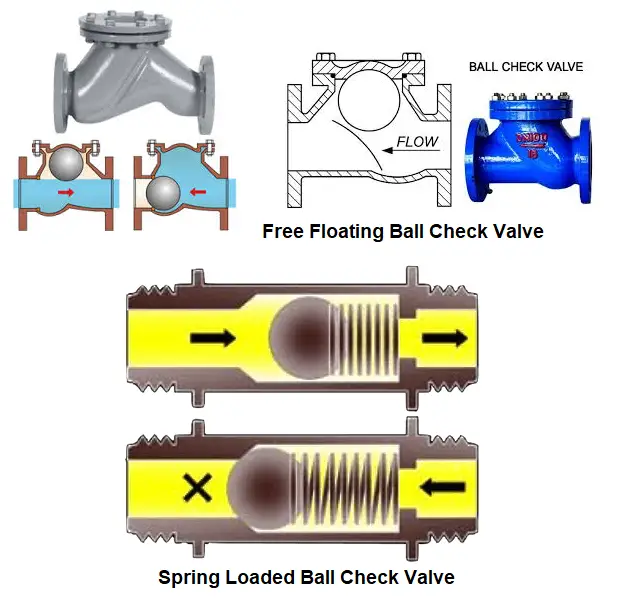
Diaphragm check valves
Diaphragm check valves consist of rubber flexing diaphragms or self-centering discs for preventing backflow. When the inlet pressure is increased, the diaphragm flexes open, and flow starts. There are two types of diaphragm check valves;
- Free-floating Normally Open Valve and
- Fixed Flexing Normally closed Valve.
In the case of normally open diaphragm valves, no cracking pressure is required as the self-centering elastomeric diaphragm is free-floating. However, they need back pressure to close the valve. On the other hand, normally closed valves need a certain inlet pressure to overcome the elasticity of the fixed diaphragm.
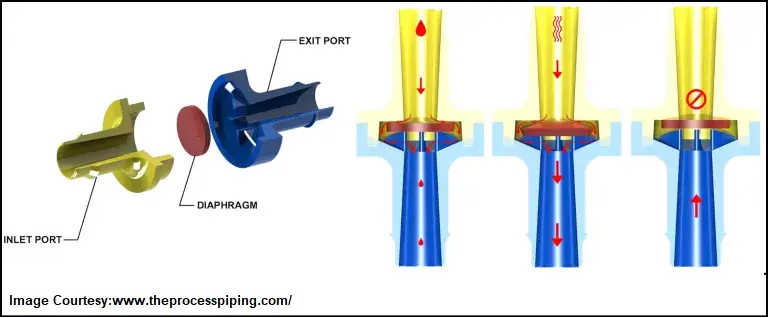
Due to very low cracking pressure, Diaphragm check valves find their use in low-pressure and vacuum applications.
Lift check valve
A lift check valve is also known as a piston check valve. It consists of a guided disc that raises (lifts) up from the valve seat and creates space for media to flow. The inlet pressure must be more than the cracking pressure to overcome gravity and/or a spring force. The valve will close when the inlet pressure decreases below the cracking pressure or there is back pressure.
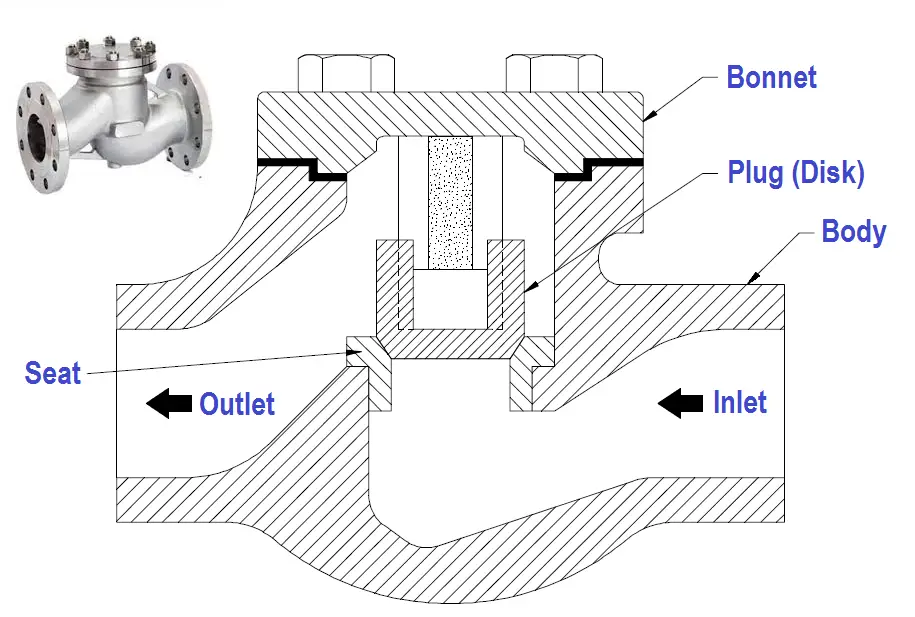
Stop check valve
A stop-check valve is basically, two valves built into one body. It can act as a globe valve for isolation or regulation purposes. Again, It can act as a check valve to prevent backflow. Contrary to other check valves, the Stop check valve has an additional external control mechanism in a perpendicular or angular direction. Stop Check valves are popular in steam services like power plants, boiler circulation, steam generators, turbine cooling, and safety systems.

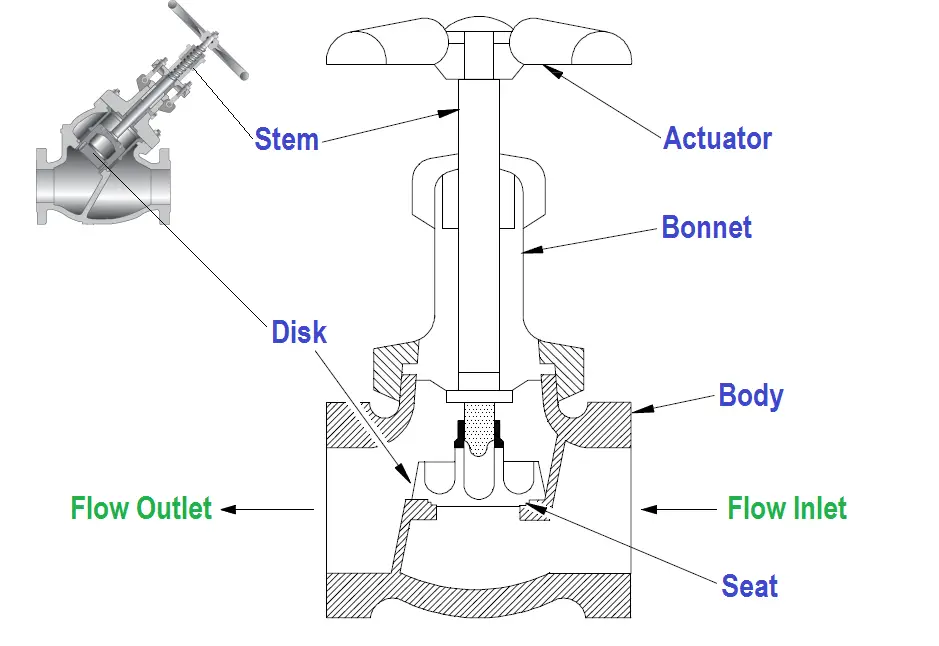
Foot Valve
A foot valve is a check valve that has a strainer installed on the inlet side to prevent debris from entering the valve.
Duckbill Valve
Duckbill Check Valves are unique, one-piece, elastomeric components that enable flow to proceed through a soft tube that feeds into the downstream side of the valve wherein back pressure collapses the tube and cuts off the flow.
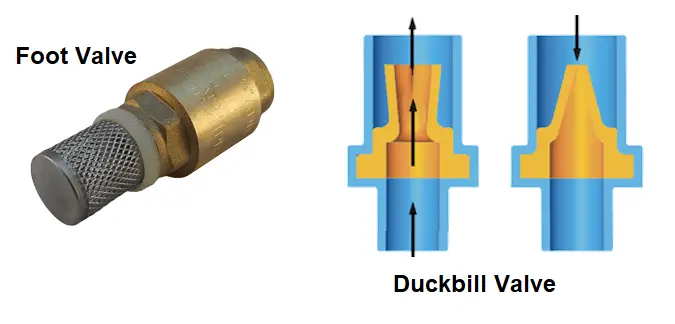
Dual Plate Check Valve
Dual-plate check valves are wafer-type compact valves with a small overall length. They provide excellent hydrodynamic properties that result in very low-pressure losses and they are technically efficient. Their low weight provides advantages during installation, transport, and storage. Dual-plate check valves are suitable for liquid, gas, steam, condensate, water supply, and oil and natural gas services. They are designed as non-slam types. With suitable springs, they can be installed in any position.

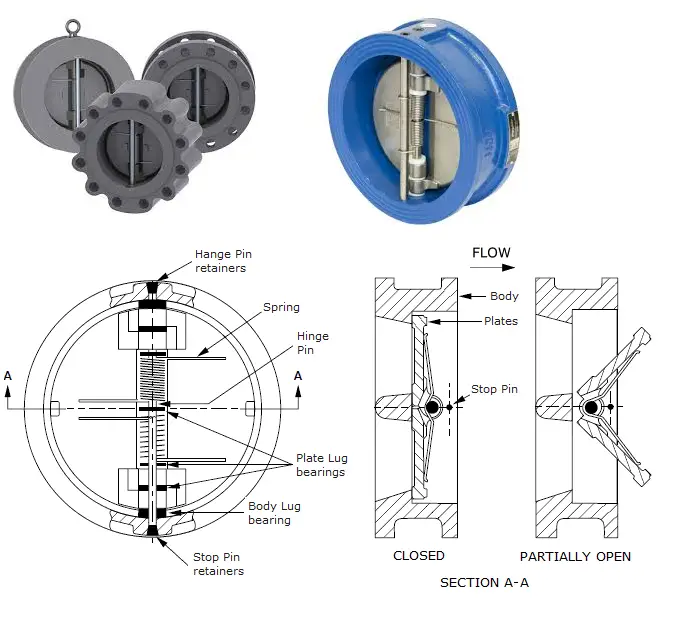
What is Check Valve Slam?
The check valve slamming phenomenon can be described as follows:
- The ideal check valve is one that closes at the moment the fluid being transported reaches “zero” velocity prior to flow reversal.
- But, No check valve is closed at the point of “zero” flow.
- Closure of the valve occurs after flow reversal has taken place.
- The mean velocity of the fluid is backward at the instant of closure.
- The magnitude of the reverse velocity, Vr, causes the phenomenon of “check valve slam”
- Check valves have “dynamic behavior”, ie “speed of response”. Different check valves behave differently.
- Check valves have “Dynamic Characteristics”, ie different speeds of response, which determines the maximum reverse velocity, Vr max, and, hence, the degree of “check valve slam”.
- The quick slamming creates a pressure spike that is a probable cause of the water hammer.
Non-Slam Check Valve
Non-slam check valves are specifically designed valves where the closing member closes without
slamming preventing excess pressure spikes. The disc of a non-slam check valve includes an internal spring opposing the opening fluid flow pressure. When the flow media is strong enough, the spring compresses and the valve opens. Again when the flow decreases, the disc is smoothly pushed back toward the valve seating surface by the spring force and stops. For vertical piping runs or complex applications requiring constant and controllable pressure levels, Non-slam check valves are an ideal solution.

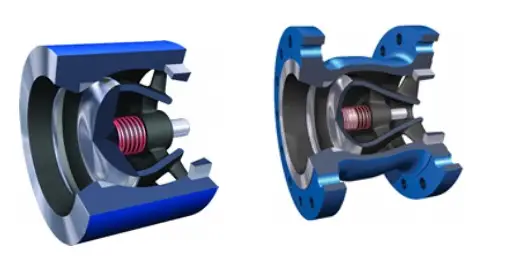
The main advantage of non-slam check valves is their ability to effectively prevent water hammer. Hence, pressure swings, vibrations, and component damages are ideally eliminated. As Non-slam valves have a short
stroke, they facilitate quick soft closing of the disc to prevent water hammer. As they consist of only one moving part, the disc itself, non-slam check valves experience minimal wear over time. However, the non-slam check valves are not piggable.
Desirable Design Characteristics of a check valve
For a check valve to work smoothly the following design characteristics are desirable:
- Moving parts of the valve are of low inertia
- The distance/angle through which the moving element(s) have to travel is minimal and
- Mechanical assistance of closure motion of moving element(s), e.g. spring.
- Tight seal leakage
- Lower pressure loss

Check Valve Symbols | Symbols for Check Valves
Check valve symbols are visual representations used in schematic diagrams to denote the presence and type of check valve. Standardized by organizations like the International Organization for Standardization (ISO) and the American National Standards Institute (ANSI), these symbols ensure consistency and clarity. Below are some common check valve symbols:

The following figure also shows certain non-return valve symbols that are used in different organizations for different types of check valves.
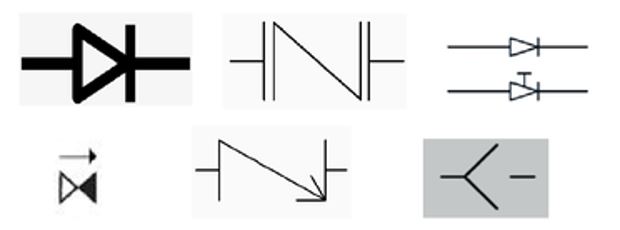
Comparison of Check Valve Symbols for Different Types of Check Valves
Different types of check valves have unique symbols to show how they work. Each symbol highlights the valve’s specific mechanism:

- Swing Check Valves: The symbol has an arc or semicircle to show the swinging motion of the valve disc.
- Lift Check Valves: The symbol includes a perpendicular line or dot to indicate the lifting mechanism that controls the flow.
- Ball Check Valves: The symbol features a ball inside the valve body outline to represent the ball’s movement.
- Diaphragm Check Valves: The symbol has a curved line or diaphragm to show the flexible diaphragm controlling the flow.
- Wafer Check Valves: The compact symbol between two parallel lines shows the valve is placed between flanges.
These symbols help engineers and technicians quickly identify and understand the type of check valve in a system.
Engineering Drawings Where Check Valve Symbols used
All the above check valve symbols are used specifically in the following drawings to represent a specific type of check valve application in the piping system:

- P&ID
- Flow Diagram
- Piping GA Drawings
- Isometric Drawings, etc
Materials of Check Valve
Industrial check valves are available in various materials like
- Carbon Steels
- Stainless Steels
- Duplex Stainless Steel
- High Nickel Alloys
- Titanium
评论
发表评论